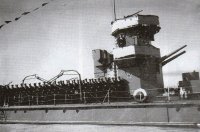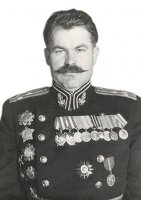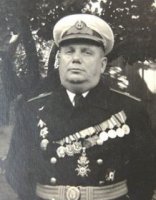On April 4, 1945, during fierce battles and a deep roundabout maneuver by the troops of the 2nd Ukrainian Front under the command of the Marshal of the Soviet Union Rodion Malinovsky, Bratislava was liberated with the participation of the Danube Soviet flotilla.
This year is the 75th anniversary of the liberation of the Slovak capital from Nazi invaders. It is very important to remember the heroes of those fierce battles.
We bring to your attention an interview with the head of the Department of Culture of the Stare Mesto District of Bratislava - Mr. Ernst Guska. Questions were asked by Anitsa Shkodova.
A.SH: Mr. Guska, you are famous for excellent knowledge in the field of history. Your presentation on a topic close to the Danube River was announced. What are you going to talk about?
E.G: This year we celebrate the 75th anniversary of the end of World War II, the Great Victory over fascism and nazism. We were convinced that this victory would be final. Unfortunately, events in our country, as well as in other countries, show that severed heads grow back.
 I want to talk about the role that was played by the Danube Flotilla in the battles for the liberation of the southern parts of Slovakia and the city of Bratislava. We are all familiar with shots from films of running soldiers and advancing tanks - it is easier to describe and portray. However, not much is known about the specific role played by the sailors of the Danube Flotilla and their battle boats.
I want to talk about the role that was played by the Danube Flotilla in the battles for the liberation of the southern parts of Slovakia and the city of Bratislava. We are all familiar with shots from films of running soldiers and advancing tanks - it is easier to describe and portray. However, not much is known about the specific role played by the sailors of the Danube Flotilla and their battle boats.
It was a “Mighty Handful,” to use terminology from the history of music. The Danube flotilla is small in number, but huge in its historical value.
Who will today remember such names as: Vice-Admiral Kholostyakov, 2nd-Class Captain Arzhavkin, Counter-Admiral Matushkin and others? Moreover, they are all honorary citizens of the city of Bratislava. Of particular interest is the personality of Vice-Admiral Kholostyakov. Unfortunately, his sad fate and death, many years after the end of World War II, are no less interesting. All this must be constantly remembered.
A.Sh .: Mr. Guska, you used to work as a director of the Transport Museum in Bratislava. Do you have any dreams in this regard?
 E.G: Yes, I have a dream. This is the creation of the Danube Museum. The river and landscape determined the development of transport and trade, formed the city of Bratislava. The Danube, however, we still perceive as an obstacle. We are forced to build bridges over it, instead of taking advantage of its huge potential. At the end of the Winter Port, there are five national cultural monuments of national importance in one place - the "Sturec" ship, produced in 1937; a ship elevator; the House of Sailors; a ship hangar and the pumping station.
E.G: Yes, I have a dream. This is the creation of the Danube Museum. The river and landscape determined the development of transport and trade, formed the city of Bratislava. The Danube, however, we still perceive as an obstacle. We are forced to build bridges over it, instead of taking advantage of its huge potential. At the end of the Winter Port, there are five national cultural monuments of national importance in one place - the "Sturec" ship, produced in 1937; a ship elevator; the House of Sailors; a ship hangar and the pumping station.
Well, I have one more, very small dream. I would like to buy a large model of one of the most famous fighting ships of the Danube Flotilla - the “Zheleznyakov ship.
***
"Zheleznyakov" ship is one of the most famous ships of the Danube Flotilla, a low-sided armored ship with powerful artillery weapons.
During the war, "Zheleznyakov" sailed over 40,000 kilometers, repelled 127 air attacks, destroyed 13 artillery and mortar batteries, 4 enemy infantry battalions, 2 ammunition depots.
Since 1967 it was erected as a monument on the Rybalsky Peninsula in Kiev.
The Danube Flotilla is an association of warships and ships of the Black Sea Fleet of the USSR, which took an active part in World War II, in the liberation of Bulgaria, Romania, Yugoslavia, Czechoslovakia and Austria, cities such as Budapest, Belgrade, Komarno, Bratislava, Vienna and others.
The flotilla made unexpected landings behind enemy lines. Then they were connected to ground units and strengthened their positions during the assault of cities. Sailors were especially distinguished when landing in the center of Vienna, preventing the explosion of the Imperial Bridge.
In honor of the courage and valor of the sailors of the Danube military flotilla in Bratislava, a monument on the Danube embankment was erected.
***
Honorary citizens of the city of Bratislava. Let's recall them by name!
Georgy Nikitich Kholostyakov - Vice-Admiral, Hero of the Soviet Union, commander of the Danube military flotilla. Heading the flotilia he freed Yugoslavia, Hungary, Austria, Slovakia.
He was a brave and decisive submarine commander. He passed a difficult life path. From the age of 19 he served in the Navy; was one of the first submariners to be awarded with the Order of Lenin; survived repressions on false charges, and participated in combat battles throughout the years of World War II.
He was awarded with the orders of several countries. A lot of schools, streets, and a maritime schools are named after him. Lots of books have been written about him and several films have been made about his fate.
He has tragically died at the hands of a criminal in peacetime.
More details: http://www.warheroes.ru/hero/hero.asp?Hero_id=1071
Alexander Fedorovich Arzhavkin - Counter-Admiral, commander of the river ship brigade during the Second World War, captain of the 2nd rank.
He led a group of armored ships in the battles for Komarno and Bratislava. He commanded a secret landing in Vienna, thanks to which the Imperial Bridge was saved from the explosion.
After the war he commanded the Danube Flotilla. He was awarded with the orders of several countries. Cargo ship of the Danube shipping company was named after him - "Alexander Arzhavkin".
More details: http://nikolajkalko.blogspot.com/2018/09/blog-post_29.html
Alexey Alekseevich Matushkin - member of the Military Council of the Danube Military Flotilla, Counter-Admiral.
He served in the Black Sea and Northern Fleets.
As part of the Danube Flotilla, he was one of the first to be awarded with the Ushakov Order "For the skillful leadership of the combat operations of units and ships of the flotilla and shown courage in the battles for the liberation of Bratislava and Vienna."
He was awarded with the orders of several countries.
More details: https://www.moypolk.ru/soldiers/matushkin-aleksey-alekseevich-1902-1975
Russian Ministry of Defense opens access to military archives:
This year is the 75th anniversary of the liberation of the Slovak capital from Nazi invaders. It is very important to remember the heroes of those fierce battles.
We bring to your attention an interview with the head of the Department of Culture of the Stare Mesto District of Bratislava - Mr. Ernst Guska. Questions were asked by Anitsa Shkodova.
A.SH: Mr. Guska, you are famous for excellent knowledge in the field of history. Your presentation on a topic close to the Danube River was announced. What are you going to talk about?
E.G: This year we celebrate the 75th anniversary of the end of World War II, the Great Victory over fascism and nazism. We were convinced that this victory would be final. Unfortunately, events in our country, as well as in other countries, show that severed heads grow back.
I want to talk about the role that was played by the Danube Flotilla in the battles for the liberation of the southern parts of Slovakia and the city of Bratislava. We are all familiar with shots from films of running soldiers and advancing tanks - it is easier to describe and portray. However, not much is known about the specific role played by the sailors of the Danube Flotilla and their battle boats.
It was a “Mighty Handful,” to use terminology from the history of music. The Danube flotilla is small in number, but huge in its historical value.
Who will today remember such names as: Vice-Admiral Kholostyakov, 2nd-Class Captain Arzhavkin, Counter-Admiral Matushkin and others? Moreover, they are all honorary citizens of the city of Bratislava. Of particular interest is the personality of Vice-Admiral Kholostyakov. Unfortunately, his sad fate and death, many years after the end of World War II, are no less interesting. All this must be constantly remembered.
A.Sh .: Mr. Guska, you used to work as a director of the Transport Museum in Bratislava. Do you have any dreams in this regard?
E.G: Yes, I have a dream. This is the creation of the Danube Museum. The river and landscape determined the development of transport and trade, formed the city of Bratislava. The Danube, however, we still perceive as an obstacle. We are forced to build bridges over it, instead of taking advantage of its huge potential. At the end of the Winter Port, there are five national cultural monuments of national importance in one place - the "Sturec" ship, produced in 1937; a ship elevator; the House of Sailors; a ship hangar and the pumping station.
Well, I have one more, very small dream. I would like to buy a large model of one of the most famous fighting ships of the Danube Flotilla - the “Zheleznyakov ship.
***
"Zheleznyakov" ship is one of the most famous ships of the Danube Flotilla, a low-sided armored ship with powerful artillery weapons.
During the war, "Zheleznyakov" sailed over 40,000 kilometers, repelled 127 air attacks, destroyed 13 artillery and mortar batteries, 4 enemy infantry battalions, 2 ammunition depots.
 Since 1967 it was erected as a monument on the Rybalsky Peninsula in Kiev.
Since 1967 it was erected as a monument on the Rybalsky Peninsula in Kiev.
The Danube Flotilla is an association of warships and ships of the Black Sea Fleet of the USSR, which took an active part in World War II, in the liberation of Bulgaria, Romania, Yugoslavia, Czechoslovakia and Austria, cities such as Budapest, Belgrade, Komarno, Bratislava, Vienna and others.
The flotilla made unexpected landings behind enemy lines. Then they were connected to ground units and strengthened their positions during the assault of cities. Sailors were especially distinguished when landing in the center of Vienna, preventing the explosion of the Imperial Bridge.
In honor of the courage and valor of the sailors of the Danube military flotilla in Bratislava, a monument on the Danube embankment was erected.
***
Honorary citizens of the city of Bratislava. Let's recall them by name!
 Georgy Nikitich Kholostyakov - Vice-Admiral, Hero of the Soviet Union, commander of the Danube military flotilla. Heading the flotilia he freed Yugoslavia, Hungary, Austria, Slovakia.
Georgy Nikitich Kholostyakov - Vice-Admiral, Hero of the Soviet Union, commander of the Danube military flotilla. Heading the flotilia he freed Yugoslavia, Hungary, Austria, Slovakia.
He was a brave and decisive submarine commander. He passed a difficult life path. From the age of 19 he served in the Navy; was one of the first submariners to be awarded with the Order of Lenin; survived repressions on false charges, and participated in combat battles throughout the years of World War II.
He was awarded with the orders of several countries. A lot of schools, streets, and a maritime schools are named after him. Lots of books have been written about him and several films have been made about his fate.
He has tragically died at the hands of a criminal in peacetime.
More details: http://www.warheroes.ru/hero/hero.asp?Hero_id=1071
 Alexander Fedorovich Arzhavkin - Counter-Admiral, commander of the river ship brigade during the Second World War, captain of the 2nd rank.
Alexander Fedorovich Arzhavkin - Counter-Admiral, commander of the river ship brigade during the Second World War, captain of the 2nd rank.
He led a group of armored ships in the battles for Komarno and Bratislava. He commanded a secret landing in Vienna, thanks to which the Imperial Bridge was saved from the explosion.
After the war he commanded the Danube Flotilla. He was awarded with the orders of several countries. Cargo ship of the Danube shipping company was named after him - "Alexander Arzhavkin".
More details: http://nikolajkalko.blogspot.com/2018/09/blog-post_29.html
 Alexey Alekseevich Matushkin - member of the Military Council of the Danube Military Flotilla, Counter-Admiral.
Alexey Alekseevich Matushkin - member of the Military Council of the Danube Military Flotilla, Counter-Admiral.
He served in the Black Sea and Northern Fleets.
As part of the Danube Flotilla, he was one of the first to be awarded with the Ushakov Order "For the skillful leadership of the combat operations of units and ships of the flotilla and shown courage in the battles for the liberation of Bratislava and Vienna."
He was awarded with the orders of several countries.
More details: https://www.moypolk.ru/soldiers/matushkin-aleksey-alekseevich-1902-1975
Russian Ministry of Defense opens access to military archives:




